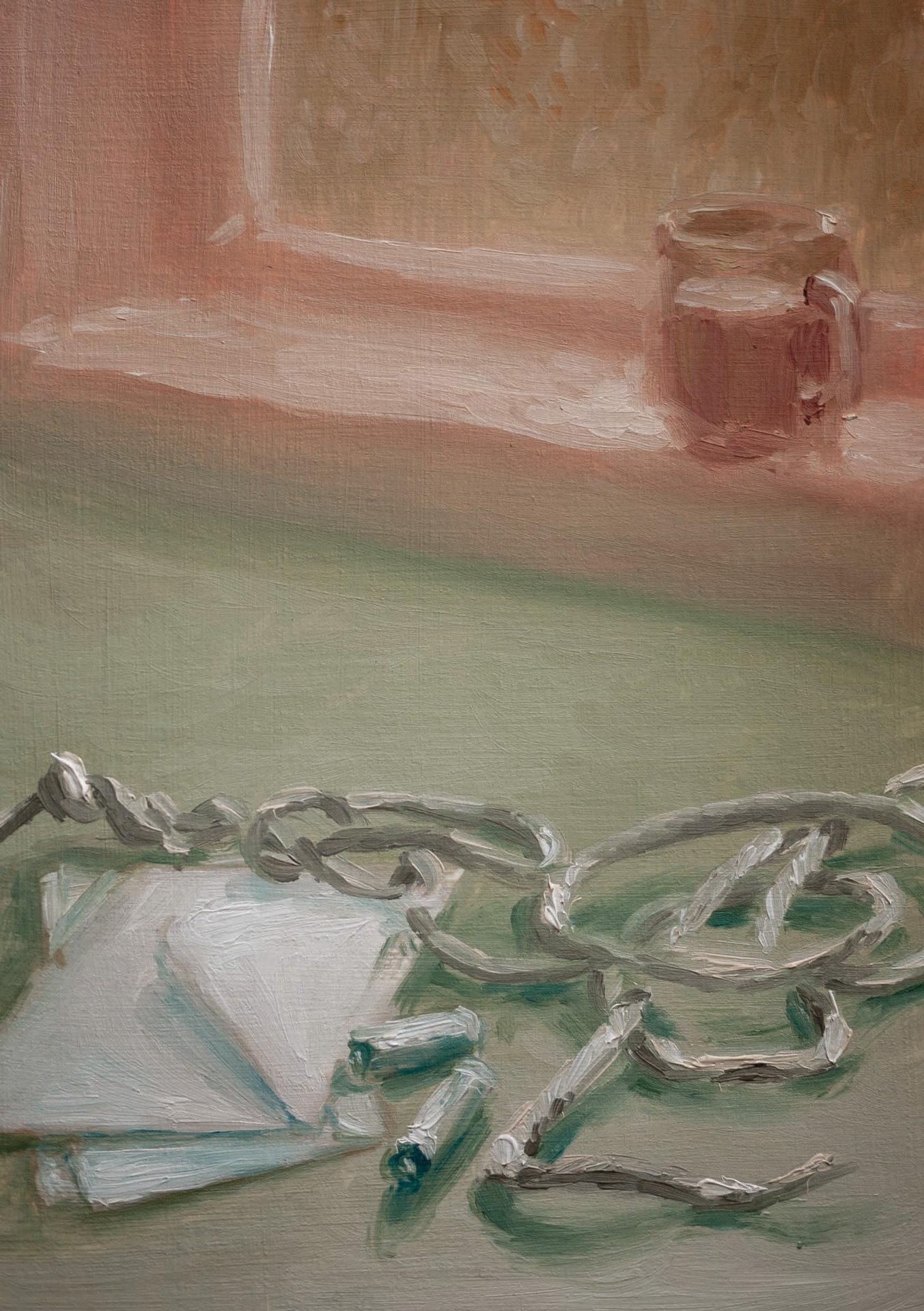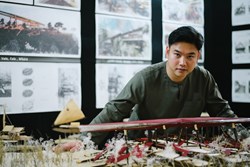This essay was highly commended in the Open category of the 2024 Warren Trust Awards for Architectural Writing.
Ode to a House
by Ross Keane
Illustration by Ruth Mitchener

The semi-detached 1940s ex-state house is located at the end of a cul-de-sac, along with two other duplexes and two stand-alone state houses.
At varying levels, Eric’s house can speak of a number of things. In context with its neighbours it talks of its role in the state housing program; closer inspection reveals the architectural details particular to its time, the use of native timber, the solid structure and quality construction. The peeling paint and unoiled hinges express the passage of time.
But for this house, it’s the sounds that define the story, that define the memories, the life within. A story of habit and routine.
A Skyline garage has been built in the front yard of the house, with a concrete driveway and a path that connects through a galvanised chain link fence to the side entry of the house beyond, where reinforced concrete steps rise up into a shallow recessed porch. A row of olive trees define the boundary to the neighbouring duplex.
“I’m 89 next birthday.”
Eric would regale stories of his life; his words conjuring visions of his childhood growing up in a worker’s cottage in Ponsonby; of summertimes spent north of Auckland working on a family orchard, where his father was raised; of a father who grew up rowing to school, and was the only one of the family who couldn’t read, yet the only one not to lose his sight. A father, who as a ship’s captain, would take his young son on crossings over the harbour, and teach him to knot like a sailor. The harbour that would later serve as a defining point in Eric’s life, when working as an electrician on the construction of the Harbour Bridge.
The house has a steep gabled concrete tile roof and painted timber bevel-back weatherboards with mitred corners and painted copper soakers perched over a continuous concrete perimeter foundation wall with a spatterdash finish.
“If you can walk to your letterbox and back everyday, then you are still ok to live in your own home.”
Numerous times a day, the front door would click as the lock turned. The squeak of the screen door opening and the clatter of it shutting signalled the start of Eric’s excursions. His shoes would tap down the worn concrete steps. The counting under his breath 1, 2, 3… ensured he wouldn’t miss a tread of the seven steps required to reach the bottom. Then came the shuffle of his feet down the concrete path, accompanied by the scrape of his cane, swinging over the cracks and crevices. The chain link gate would clink open as he walked through. Passing by the garage, a jiggle of the side door handle ensured that it was still locked. Then onwards to the letterbox, to collect mail he wouldn’t read.
The windows are painted 2 and 3 pane timber casement windows, with brass hardware. The boxed eave soffit with asbestos lining sits below the galvanised ogee profile painted gutter. There is a lean-to addition at the back of the house that has been constructed to match the original, though corrugated iron has been used due to the low pitch of the roof.
“Are you there Ross?”
If he sensed my presence in the backyard he would call out, his voice filtering through the olive trees lining the boundary; a source of great annoyance to Eric with their wispy branches brushing his face each time he walked past. “The only way to trim these back is to cut them off at the ground.” The stories would continue, some old, some new, until he remembered he was on his way to check the letterbox. Again. The tap of his cane and the clink of the gate heralding his passage onwards.
Wednesdays were bin day.
The shuffle of his feet on the concrete path would be joined by the rumble of wheels, first one bin, then the other. Each time on his way back up the path, a little jiggle on the handle. Still locked. The next day, he would open the bin lids and use his cane to knock on the inside, checking if they had been emptied. Tap, tap, tap. Then shuffle, rumble, up and back.
Back inside, the sound of the radio would travel through the open windows; the whispered murmurings of the host relating the day’s weather and discussions of an unprecedented type of illness coming out of China. The venetian blinds gently tapped against the window frame in the breeze.
Internally the original 2-bedroom layout has been remodelled to form a single bedroom, with the second bedroom being opened up to the living area to create a larger space for entertaining. The front door opens into a long hallway with doors providing access to the kitchen/dining, living space, bedroom, bathroom and separate wc. Two hall cupboards allow for coat and linen storage at either end of the hallway.
Shopping day.
I would call out as I entered,
“Hi Eric, it’s Ross. I’m here to do your shopping.”
“Is that you Ross? Batteries, I need batteries.”
Standing at the kitchen bench I would pull open the heavy drawer, the wood scraping as it moved along the old timber rails. Inside revealed countless packets of batteries. Smiling, I would write batteries on my list anyway.
The pen scratched the paper as I wrote the rest down. Lightbulbs. Kiwifruit juice. Chocolate yoghurt. Bread, butter, jam. Kitty litter and cat food for Lexi.
At the mention of her name, Lexi would purr and brush past Eric’s leg.
When I returned, he would be in the living room resting on the couch, listening to the radio and practising knots. The sound of the rope binding and intertwining in a series of loops, tying, untying. His fingers feeling each bow and twist, memorised through repetition. His head up, leaning at a slight angle as if listening to the knots themselves.
The kitchen is original, with solid timber carcases and a stainless steel sink bench. The lean-to addition allows for a casual seating space next to the kitchen. Past the kitchen, the laundry has a rear porch that connects to the back garden and hills hoist washing line. An original concrete shed with a solid green painted timber door sits in the corner.
As time went on, new sounds emerged. Repetitive and somewhat curious sounds.
I would hear the front lock click, the screen door squeak open. Ding Dong! The door bell would ring through the air. The screen door clattered, the front door banged. Silence. A moment later, the front lock would click, the screen door squeak open. Ding Dong! The screen door clattered, the front door banged. Silence.
The front lock would click…
More routines sprang up.
The flick of the light switch could be heard through the open window, flick-flick, flick-flick, flick-flick. Silence. flick-flick, flick-flick, flick-flick. Forever a sparky, he said he wanted to make sure there was no break in the circuit. I’d have to wait for him to finish his clicking routine to continue our conversations.
Sometimes I would be woken in the night, eyes still shut, the silence in the darkness broken by the flick-flick, flick-flick, flick-flick.
The timber floor, wall and roof framing is native rimu, along with the weatherboards and facings and 3 1/5 inch T&G floorboards. The internal doors are flush panel construction with rimu veneers and solid rimu jambs and architraves, as well as rimu skirtings.
Soon the trips to the letterbox became less frequent. The gap between the screen door clattering and the click of the gate grew longer. He no longer took his bins out.
But the stories remained. Tales of his good balance and how that came about, walking along steel girders during the construction of the Harbour Bridge; balance that since served him well, navigating his now invisible city.
The walls are lined with plasterboard, some rooms with a wallpaper finish, others painted. The ceiling is lined with a low density softboard and painted, with a half-round timber beading at all wall/ceiling junctions. Carpet covers the floorboards in all rooms, apart from the kitchen, laundry, bathroom and wc, with linoleum used in these areas.
It was a Thursday. I called out to Eric as I entered.
Silence hung in the air.
“Eric?”
My footsteps were soft on the worn hallway carpet.
The sound of laboured breathing led me to the living room floor, telling me something was wrong. A fall in the night. The dial tone was a loud vibration in my ear as I waited for someone to pick up.
A whisper in the quiet, “It’s going to be ok Eric, we’re getting you help.”
Suddenly it was all noise. The ambulance arrived, the paramedics took charge.
The house stands strong on its foundations. Its native bones sagging slightly under the weight of a long life, but blind to the lives unfolding around it.
Now silence.



